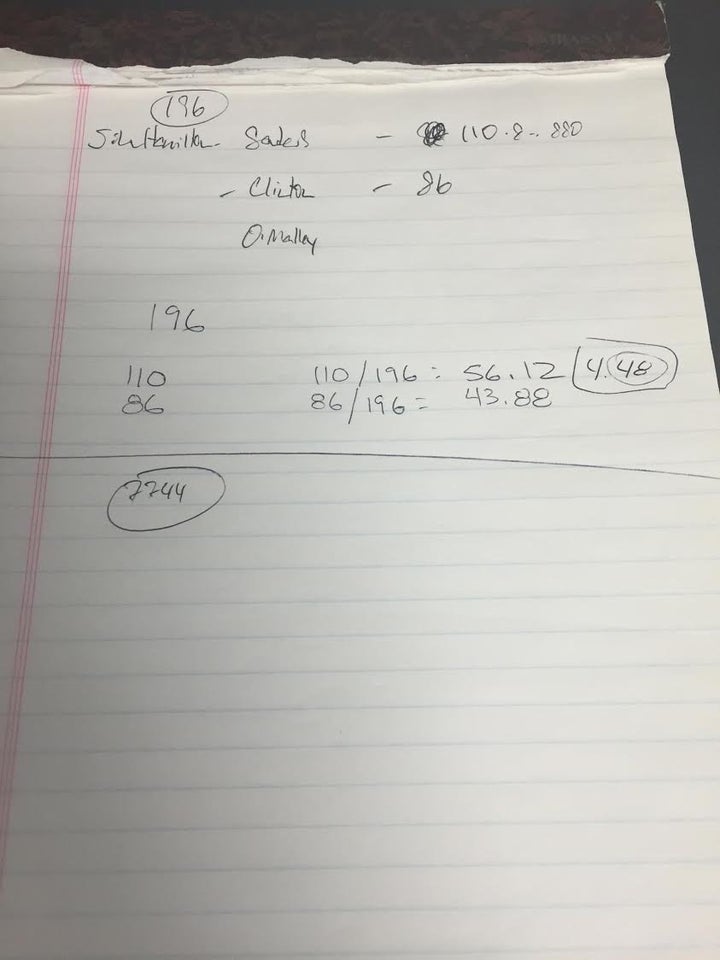DES MOINES, Iowa -- The cafeteria at North High School was buzzing with excitement on Monday night as the Democratic caucus in Des Moines Precinct 20 began. Supporters for Vermont Sen. Bernie Sanders gathered on one side of the room, while backers of former Secretary of State Hillary Clinton claimed their territory on the opposite side. This left voters wanting to caucus for former Maryland Gov. Martin O’Malley in the center of the crossfire.
Nancy Quinn was one of these caucusgoers.
"We’re trying to convince people to join our group," she said, standing on a chair and waving a sign. "We’re keeping the faith."
After 14 O’Malley supporters unsuccessfully attempted to recruit more people, it became clear they wouldn’t be able to hit the viability threshold. In most precincts, candidates are required to earn support from at least 15 percent of attendees to achieve what’s called "viability." If that doesn't happen, the supporters must align with different candidate or join an "uncommitted" category.
"People started to abandon the group when things weren’t looking good," Quinn said. "I said, 'Well, you know, don’t go until you have to.'"
Sanders supporters, waving signs and chanting his name in unison, lured the majority of O’Malley’s backers without much effort. O’Malley supporters left the signs they'd been holding on the ground and took seats on the Sanders side of the room.
It wasn’t long until all eyes were on Quinn, the only O’Malley supporter who had not followed the crowd. Instead of approaching her, most caucusgoers on either side of the room began shouting in a singsong tone, hoping that tactic would work one last time.
"I was surprised that no one came right away," Quinn said. "I was expecting more people to come up and tell me why I should be voting for someone. That was new to me."
Going into caucus night, Quinn knew she would most likely have to side with another candidate because polls had been showing that support for the former Maryland governor hovered in the single digits. But she was torn.
"I’m with everybody," she said. "I’m with Bernie on this, Hillary on this and O’Malley on this. So, it really comes down to someone telling me why I should vote for you or your candidate."
A Clinton supporter eventually approached Quinn, taking her to the side of the room and trying to persuade her to align with the former secretary of state.
"The Hillary people came and gave me some really good reasons, they were able to answer a couple of my questions," Quinn explained at the end of the evening.
No one from the Sanders side approached her until after she had expressed her support for Clinton, Quinn said.
At that point, it was too late. Quinn had made up her mind -- and she couldn't have known it would tip the scales in Clinton’s favor.
Eight delegates were up for grabs in Precinct 20. A simple formula is used to figure out how the delegates will be split: The number of people supporting each candidate is multiplied by the number of available delegates. That number is then divided by the total number of attendees, and the quotient is rounded up or down to determine how many delegates will be awarded to each candidate.
After O'Malley's supporters dispersed, 110 people at the precinct were supporting Sanders, and 86 were supporting Clinton. After a few calculations, this meant each candidate was awarded four of the available eight delegates. Sanders had more supporters, but Clinton claimed the same number of delegates because of rounding up.
For you more visual readers, here's a breakdown of what that looks like:
What happened:

What could have happened:

If Quinn had decided to align with the Sanders group, the Vermont senator would have secured five county delegates.
"The ratios were within one-tenth of a percent," said John Wagner, a Sanders supporter who was helping calculate the math. "We didn’t know at the time that if we had secured one more supporter, Bernie would have gotten five delegates. I went back and checked the math, and then I realized."

Wagner explained that this caucus seemed to move more quickly than those he has seen before.
"Typically you don’t have people rolling over that fast," Wagner explained. "O’Malley did not have a big turnout. They knew they were so far away from getting one delegate, so they just dispersed."
In a caucus that came down to a fraction of a percentage point, Quinn’s decision likely made an impact. Clinton went on to claim victory in Iowa, toppling Sanders by a slim margin of 49.9 percent to 49.6 percent. She won by the equivalent of about four state delegates.
The Iowa Democratic Party is facing some scrutiny over how volunteers handled the extremely close caucus. Some ties or rounding issues were settled with coin flips, which has concerned some media outlets and Sanders supporters.
In an editorial on Thursday, the Des Moines Register said the results were too close "not to do a complete audit." The newspaper also noted there were several opportunities for errors to arise, and called on the state party to move quickly to prove that the caucus results are accurate.
But a full recount is impossible because of how the caucuses are run, Iowa Democratic Party Chairwoman Andy McGuire wrote in an editorial published in the Register on the same day.
"Asking for raw vote totals demonstrates a misunderstanding of our process," McGuire wrote. "As does asking for a recount."
"Monday night's caucuses were a unique set of circumstances that would be impossible to duplicate or to recount," she continued.
Perhaps no one is more aware of that than Quinn.
"I just love this experience because it really makes people have to decide why they’re doing what they are doing," Quinn said. "I honestly didn’t realize things would be this close."
Also on HuffPost:


